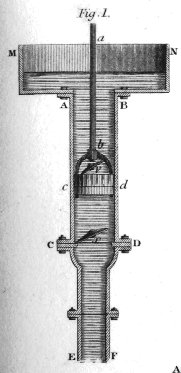15th Century Pump
Today, we speak of bilge water and exploration. The University of Houston's College of Engineering presents this series about the machines that make our civilization run, and the people whose ingenuity created them.
What was the most important supply item on board a sailing ship? Was it canvas? Spare masts? Food? Water? Texas marine historian Thomas Oertling flatly states that a compact, efficient pump was most important of all.
Just imagine, if you can, sailing a thousand miles from any shore and finding you have a loose seam below the waterline. Imagine riding a wooden vessel with the ocean seeping in faster than it should. We call that leakage bilge water; and bilge remains a nasty word even today.
After Columbus, voyages stretched into months, and bilge water became terrifying stuff indeed. History books don't say when the suction pump replaced bailing buckets. It was invented 60 years before Columbus, but as a laboratory curiosity. Miners put it to work on a different kind of bilge a generation after Columbus. They found they could drive their shafts deeper into the earth once they could get rid of the water that seeped in.
Those first suction pumps were pretty simple -- long tubes with plungers down the middle. You pulled the plunger and it sucked water up from below -- like a hypodermic needle in reverse. The plunger had a leather flap valve. It let water through when you pushed it down, but the flap sealed it tight when you lifted it up. A laborer pushed the plunger up and down, and water flowed steadily upward.
But in 1982 we finally found a shipboard pump that predated those mining pumps. Marine archaeologists dove into a wreck off Molasses Reef in the British West Indies. They found a four-inch lead plunger with valve holes in it. It was part of a suction pump installed right after Columbus's first voyage.
This mute remnant tells a story about technology and the world around it -- a story you can't find in written records. The suction pump had little purpose when the world began opening up to exploration. Intellectual play, not necessity, drove its invention. Now, all at once, miners and shipbuilders alike pressed it into the service of an expanding world.
The simple suction pump was a subtle machine. It's far easier to understand it than it ever was to invent it. We're reminded of the nursery rhyme of the kingdom and the horseshoe nail. The kingdoms of the Western Hemisphere and of the subterranean world both depended on the suction pump. This small voyage of somebody's inventive mind made far grander voyages possible.
I'm John Lienhard, at the University of Houston, where we're interested in the way inventive minds work.
(Theme music)
Oertling, T.J., A Suction Pump from an Early 16th-Century Shipwreck. Technology and Culture, Vol.30, No. 3, 1989.

From the 1832 Edinburgh Encyclopaedia
Construction of a simple flap valve